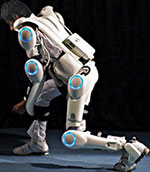Exoskeleton technology poised to transform factories of the future
January 2017
News
Automation and artificial intelligence are paving the way for human robotic collaboration, finds Frost & Sullivan’s Visionary Innovation Team. Exoskeletons, both passive and active, will see higher adoption across industries such as automotive, manufacturing, defence and healthcare. In factory settings, they can empower workers, improve ergonomy and provide safety by increasing automation, thus improving quality, reducing waste, and lowering levels of absenteeism due to injuries. Understanding the costs, benefits and return on investment (ROI) of exoskeleton integration into assembly lines could also be the first step toward human robotic collaboration (HRC).
The Hybrid Assistive Limb (HAL) is a powered exoskeleton suit developed by Japan’s Tsukuba University and Cyberdyne to expand the physical capabilities of its users, particularly people with physical disabilities.
“Exoskeletons will play a critical role in the future of smart factories,” noted Frost & Sullivan Visionary Innovation Group research analyst Vijay Natarajan. “By 2020, firms across most industries will use some form of exoskeleton technology and by 2025, concepts such as HRC will likely replace exoskeletons, resulting in increased collaboration between humans and robots.”
The potential for seamless integration within a factory setting, lower maintenance costs, and an attractive ROI with a payback period of less than one year indicate tremendous promise for the exoskeleton technology, but challenges remain:
• Currently, there are no regulations that bind exoskeleton use on factory floors. A proper regulatory framework needs to be incorporated to ensure that safety requirements pertaining to technology use is met.
• A negative perception of machines replacing human beings, instead of assisting them, lingers. Further, the debate about who is in control, the machine or the user, is a concern among most users.
As significant cost benefits in terms of productivity and insurance for workers propel exoskeleton technology forward. Several players are offering innovative solutions including Noonee, Exso Bionics, Cyberdyne, Active Bionics, Robo Mate Consortium, Lockheed-Martin, Bioservo Technologies and Sarcos.
“The evolution of artificial intelligence and machine learning will eventually result in intelligent autonomous robots that sense surroundings and work effectively with human beings to initiate multi-fold levels of efficiency,” concluded Natarajan. “In that sense, exoskeletons have a very unique role in future human-robot or cobot factories.”
For more information contact Samantha James, Frost & Sullivan, +27 (0)21 680 3574, [email protected], www.frost.com
Further reading:
Meeting the Western Cape’s occupational health and safety needs
News
“A-OSH EXPO Cape Town is a dedicated platform where visitors can explore the latest products, services and training to safeguard their teams, improve workplace conditions, and ensure compliance with evolving legislation.
Read more...
SKF crowned champions in Sishen service provider competition
SKF South Africa
News
SKF wins Sishen service provider competition.
Read more...
Bühler hosts Student Career Expo
News
Bühler Southern Africa recently hosted its fourth annual Student Career Expo, reaffirming its commitment to inspiring and guiding the next generation towards diverse and rewarding career possibilities.
Read more...
Navigating global uncertainty through human-centred risk management
News
Global uncertainties are no longer exceptional events, they are the environment in which we work. This reality places new demands on how we manage risk.
Read more...
Africa Automation Indaba 2026: Catalysing a connected, competitive industrial future
News
Africa’s automation and process control landscape is poised for a major milestone with the launch of the Africa Automation Indaba, taking place from
13 to 14 May 2026 at the Radisson Collection Hotel, Waterfront, Cape Town.
Read more...
The unseen crisis in our taps
News
South Africa’s water crisis is no longer looming. It is already here. To move forward, water treatment must become part of a broader infrastructure renewal agenda. This includes decentralised solutions, private-sector innovation and long-term investment.
Read more...
German experts for bulk solids measurement technology join forces
Mecosa
News
MÜTEC Instruments in Germany has acquired DYNA Instruments. the German manufacturer of inline moisture and mass flow measurement systems.
Read more...
Specialised Exhibitions transitions to new name: Montgomery Group Africa
News
As part of a strategic move to streamline operations, strengthen regional alignment and support long-term growth, Specialised Exhibitions has transitioned to a new name: Montgomery Group Africa.
Read more...
RS South Africa and Qhubeka empower learners through the gift of mobility
RS South Africa
News
RS South Africa, in partnership with Qhubeka Charity, is continuing to make a tangible difference in the lives of South African learners through its bicycle donation initiative.
Read more...
A technical partnership that lasts
Omniflex Remote Monitoring Specialists
News
Ian Loudon, international sales and marketing at remote monitoring specialist, Omniflex reflects on the longevity of the partnership with Sasol, the key technology milestones along the way, and the most recent project in South Africa.
Read more...


